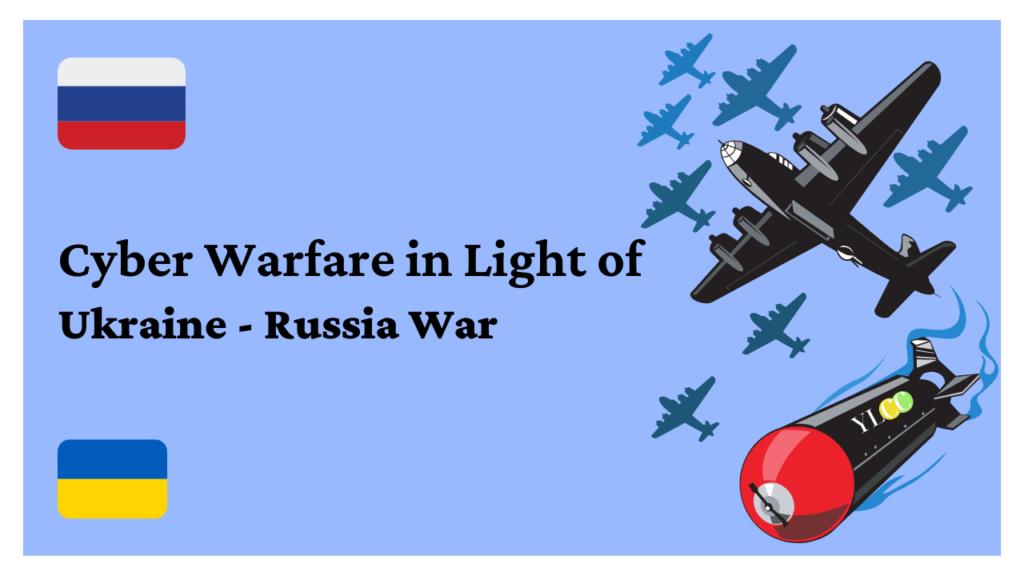
A New BattleFront!
Background
- Since Russia began its disastrous full-scale invasion of Ukraine in February, the cyberwar that it has long conducted against its neighbour has entered a new era as well.
- This new period is one in which Russia has at times appeared to be attempting to establish the role that its hacking operations should play in the middle of a terrible, physical ground war.
- Websites and financial services held by the state have come under more frequent and sophisticated cyberattacks.
- These attacks initially took the form of Distributed Denial of Service (DDoS) attacks before escalating to the use of complex wiper malware and ransomware.
Cyber Warfare: What Exactly Is It?
- As a relatively new kind of warfare, cyberwarfare is utilized by governments who would rather avoid an all-out military conflict but yet want to make a statement.
- A cyberattack can cause computers to malfunction on purpose, steal information, or be used as a springboard for more attacks.
- Attacks on computer networks may be carried out in many different ways by cybercriminals, including the deployment of malicious software, social engineering, encryption, and even a complete overload of the system.
- Due to the ability to constantly annoy and weaken geopolitical opponents, cyberwarfare is a never-ending fight for many nations.
Cyber Warfare Through the Years
- Stuxnet, the first cyber weapon designed to cause physical damage, was deployed in 2010. According to reports, Stuxnet was able to destroy 20% of the centrifuges that Iran was using to create its nuclear weapons.
- Then, beginning in 2014 and continuing through 2016, Russia carried out a series of strategic attacks against the Ukrainian government and the German parliament.
- During the same time period in question, Chinese hackers broke into the United States Office of Personnel Management and stole 21.5 million records containing personal information about American workers.
- More than 200,000 computers in 150 countries were compromised with WannaCry ransomware in 2017.
- More than $10 billion in losses were caused by the NotPetya cyberattack, which began in Ukraine and destroyed files.
Ukraine-Russia War
- While reports date the attack to the early hours of February 24, 2022, Russia has actually been waging cyber warfare against Ukraine for some time, initially as psychological warfare and more recently in a destructive manner.
- Since the year 2020, Ukraine has been one of Russia’s top targets. The wave of attacks sent around the middle of January took down the websites for the foreign affairs ministry and the education ministry.
- The war’s opening salvo was unleashed in cyberspace. The very first weapon fired…hit over 300 targets across the Ukrainian government, including IT companies, banks, and agricultural organizations.
- The first three days of the conflict saw a staggering increase of 196% in the number of cyberattacks launched against the government and military of Ukraine.
- The Russian military used DDoS as a warfare tactic. Distributed denial of service attacks (DDoS) are disruptive because they flood websites with more traffic than their servers can handle.
Conclusion
- Artificial intelligence, machine learning, and quantum computing are some examples of the new technologies that have opened up new doors of opportunity.
- It is now more important than ever to have a solid understanding of the nature of the threat posed by cyberspace and to implement appropriate preventative measures.
- There is an urgent need for India to prioritize cyber security over information technology security.
- Instead of worrying about their reputations, companies that have been the target of cyberattacks should immediately report the incident to the appropriate authorities.
- It is essential to have crisis management plans in place so that one can respond appropriately in any given circumstance.
- Establishing a specialized industry forum for cyber security is recommended in order to cultivate reliable indigenous solutions for the prevention of cyberattacks.
- Coordination between the Computer Emergency Response Teams (CERTs) of various nations is required in order to protect the most vulnerable members of society from the malicious schemes that cybercriminals have developed.
- Perhaps it seems ironic to call for the creation of even more international rules in the wake of Russia’s egregious violations of the most sacred of international law provisions, including those pertaining to the use of force and the protection of territory. But it isn’t.
- A future dangerous escalation of the conflict could be avoided, or at least mitigated, with a clearer understanding of the rules governing cyber operations.
YLCC would like to thank Pearl Narang for her valuable input to this article.






